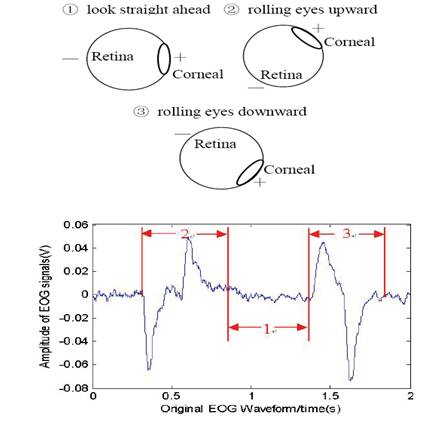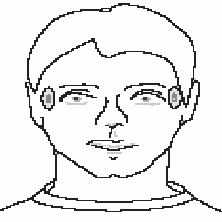





Published on Feb 14, 2025
Electrooculography (EOG) is a new technology of placing electrodes on user's forehead around the eyes to record eye movements . This technology is based on the principle of recording the polarization potential or corneal-retinal potential (CRP), which is the resting potential between the cornea and the retina. This potential is commonl y known as electrooculogram.
(EOG) is a very small electrical potential that can be detected using electrodes. The EOG ranges from 0.05 to 3.5 mV in humans and is linearly proportional to eye displacement.
Compared with the electroencelography (EEG), EOG signals have the characteristics as follows: the amplitude is relatively the same (15-200uV), the relationship between EOG and eye movements is linear, and the waveform is easy to detect. Considering the characteristics of EOG mentioned above, EOG based HCI is becoming the hotspot of bio-based HCI research in recent years.
Basically EOG is a bio-electrical skin potential measured around the eyes but first we have to understand eye itself:
The electrooculogram (EOG) is the electrical signal produced by the potential difference between the retina and the cornea of the eye. This difference is due to the large presence of electrically active nerves in the retina compared to the front of the eye. Many experiments show that the corneal part is a positive pole and the retina part is a negative pole in the eyeball. Eye movement will respectively generates voltage up to 16uV and 14uV per 1° in horizontal and vertical way. The typical EOG waveforms generated by eye movements are shown in Fig 3.2 .
In Fig 3.2 the diagram top figure shows the three types of eye movements and the bottom figure shows the original EOG waveform.
Positive or negative pulses will be generated when the eyes rolling upward or downward. The amplitude of pulse will be increased with the increment of rolling angle, and the width of the positive (negative) pulse is proportional to the duration of the eyeball rolling process.
When the eyes are stationary or when the eyes are looking straight ahead, there is no considerable change in potential and the amplitude of signal obtained is approximately zero.

Fig 3.2 EOG generation using the eye movements and EOG waveform
When the eyes are made to move upwards, then there results an action potential, which when measured will give a value of -0.06v to +0.06v. Similarly a downward movement of the eyes will give a similar voltage with opposite polarities to that obtained due to the left movement.
The important factor regarding the EOG signal is that it does not fall in the amplitude or frequency range of the EMG signal ,thus during the process of measurement of the EOG signals ,the head or other parts of the body can be moved ,as these muscular activities will not interfere with the EOG signals and can be filtered easily.
The ECG signal can be easily filtered out from the EOG signals by using a low pass filter, as the ECG signals have a higher bandwidth. One more interesting factor regarding the ECG signals are that, it does not interfere with the EOG signals, because when EOG is measured using precision electrodes, and as ECG is generated by the heart it does not get detected by the electrodes placed near the eye.
The primary function in EOG signal estimation and processing is the detection of the EOG signals. The detection takes place as shown below.
The below figure shows the method of detection of EOG signals using electrodes

Fig 5.1: Electrode placements for EOG detection
As it can be seen from the above figure, four to five electrodes are required for the detection of the EOG signals. In the process of detection, the electrodes act as a transducer converting the ion current obtained at the skin to electron current. The derivation of the EOG is achieved placing two electrodes on the outer side of the eyes to detect horizontal movement and another pair above and below the eye to detect vertical movement.
| Are you interested in this topic.Then mail to us immediately to get the full report.
email :- contactv2@gmail.com |